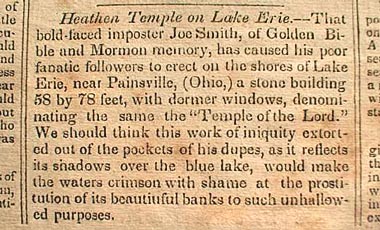
READINGS IN EARLY MORMON HISTORY
(Newspapers of NEW YORK)
New York City Papers of M. M. Noah
The Evening Star
1833-40 Articles

M. M. Noah's response to the building of the Kirtland Temple
M. M. Noah's New York City Papers:
|
1817-1826 Nat. Advocate (1817-24) NY Nat. Advocate (1825-6)
1826-1829 New York Enquirer 1829-1833 Morning Courier & New York Enquirer 1833-1840 The Evening Star 1840-1851 Noah's Weekly Messenger |
Oct ? 1835 Jul ? 1837 Nov ? 1837
(volunteers needed to copy more articles for this web-page)
Articles Index | Spectator/Com. Adv. | Misc. NYC papers
 No. New York, October ?, 1835. Vol. ?
Heathen Temple on Lake Erie. -- That bold-faced imposter, Joe Smith, of Golden Bible and Mormon memory, has caused his poor fanatic followers to erect on the shores of Lake Erie, near Painesville, (Ohio,) a stone building 58 by 78 feet, with dormer windows, denominating the same the "Temple of the Lord." We should think this work of iniquity extorted out of the pockets of his dupes, as it reflects its shadows over the blue lake, would make the waters crimson with shame at the prostitution of its beautiful banks to such unhallowed purposes. |
 No. New York, July ?, 1837. Vol. ?
MORMONS. -- These crazy fanatics have their grand Tabernacle at a place they call Kirtland, 5 miles from the shore of Lake Erie, and 20 miles from Cleveland, and count no less than 4000 persons under their leader, Joe Smith. They have been lately joined by a shrewd literary person, named Sydney Rigdon, formerly a preacher of the doctrine of Campbell. He is the Grand Vizer to Smith; and under their decision a banking house has been established, of which Smith is president and Rigdom cashier. The issues have been about $150,000. -- The bank failed. They have several mills on their property. The houses are small, including the Prophet Joe's. The temple is a beautiful building of rough stone, three stories high, and 70 to 75 feet square. Each of the two principal apartments holds twelve hundred persons. The joists of the interior are supported by six fluted columns. Each apartment contains six pulpits, arranged, gradatim, three at each end of the "Aaronic priesthood," and [three] at the other end for the "priesthood of Melchisidec." The slips are so constructed, that the audience can face either pulpit, as may be required. In the highest seat for the "Aaronic priesthood," sits the reverend father of the prophet; the next below is occupied by Joe, and his prime minister, Rigdon. The attic story is occupied as school rooms, five in number, where the various branches of English, Latin, Greek and Hebrew languages are taught to a great number of students. The actual cost of the temple is not known, but it is estimated to have cost not less than $60,000. |
 No. New York, Nov. ?, 1838. Vol. ? THE MORMON WAR. FURTHER PARTICULARS. -- By our mail papers from the West, we learn that in addition to the previous sad intelligence, the reports are confirmed, that the Mormons, before the bloody encounter, had given increased provocation to the citizens by burning the Post Office in Daviess co., the court house, also, it is affirmed, together with several stores, a village called Millport, and captured $30,000 worth of property from the citizens of that county. They had also, it appears, challenged Ray county, on the confines of which the conflict took place, saying that they were now ready for her; that having taken arms and magazines enough from the Daviess citizens, to supply all their deficiency in that line, they cannot be whipped. They have threatened to burn Elkhorn and [Bookum?] |
Back to top of this page.
Newspaper Articles | News Articles Index | History Vault
Oliver's Bookshelf | Spalding Library | Mormon Classics
last updated: Jan. 1, 2006